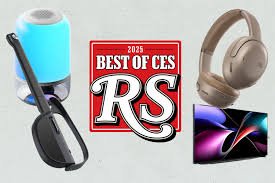
Introduction
Every year brings a wave of new devices that transform how we live, work, and connect. While some gadgets fade into obscurity, others fundamentally reshape industries and consumer habits. In 2025, several product categories are experiencing rapid growth, driven by advances in design, software integration, and user-centered functionality. From wearables that track health in real time to smart home ecosystems that respond intuitively, the latest generation of devices reflects a blend of convenience, efficiency, and sustainability.
The Rise of Health-First Wearables
Wearable technology has evolved from step counters to comprehensive health companions. Today’s smartwatches and fitness trackers monitor heart rate variability, blood oxygen levels, and even detect signs of stress. Recent models use AI-driven algorithms to anticipate potential health issues before symptoms become obvious. Beyond fitness, wearables now integrate seamlessly with telemedicine platforms, allowing doctors to access live health data and adjust treatments accordingly. Analysts expect the market for health-focused wearables to surpass $130 billion by 2030, fueled by growing consumer demand for proactive wellness tools.
Smart Home Devices That Learn from You
Smart homes are no longer futuristic concepts but mainstream realities. Devices like intelligent thermostats, voice-activated assistants, and AI-driven security cameras adapt to user habits, creating personalized environments. For example, lighting systems now adjust not just based on time of day but also on an individual’s circadian rhythm, improving sleep quality. Similarly, kitchen appliances track dietary preferences, suggesting healthier recipes and even automating grocery lists. With energy costs rising, connected devices that optimize consumption also help households reduce expenses while contributing to sustainability goals.
Portable Tech for Remote Work
The shift toward hybrid and remote work has fueled demand for portable devices that enhance productivity. Lightweight laptops with extended battery life, foldable displays, and noise-canceling earbuds are in high demand. Portable monitors allow workers to replicate multi-screen setups while traveling, and compact projectors turn any space into a presentation-ready office. Companies are also releasing advanced webcams with AI-driven framing and lighting adjustments, ensuring professional-quality video calls. This emphasis on mobility demonstrates how gadgets adapt to cultural and professional shifts in real time.
Next-Generation Smartphones
Smartphones remain central to the gadget landscape, but their form and function continue to evolve. Folding screens have moved beyond novelty, offering durability and versatility for multitasking. Camera technology is also advancing rapidly, with flagship devices rivaling professional-grade equipment through computational photography. Integration with satellite communication has emerged as a new safety feature, allowing users to connect even in remote regions without cellular coverage. As 5G infrastructure expands, smartphones increasingly serve as hubs connecting wearables, vehicles, and smart homes.
Gaming and Entertainment Gadgets
Gaming has grown into a multibillion-dollar industry, and new gadgets enhance immersion. Handheld gaming consoles with cloud streaming capabilities allow players to access AAA titles on the go. Virtual reality (VR) and augmented reality (AR) headsets continue to gain traction, offering not just gaming experiences but also training simulations and collaborative design platforms. Audio innovations such as spatial sound earbuds and adaptive noise isolation contribute to immersive entertainment. These developments blur the line between traditional gaming and broader digital experiences.
Eco-Friendly Innovations
One of the most notable trends in 2025 is the shift toward environmentally responsible design. Gadgets now increasingly feature recyclable materials, modular components for repairability, and low-energy consumption. Solar-powered chargers, biodegradable phone cases, and energy-efficient appliances cater to eco-conscious consumers. Tech companies are also under regulatory pressure to meet sustainability standards, leading to broader adoption of circular economy models. Consumers benefit not only from greener devices but also from longer product lifecycles that reduce waste.
AI-Powered Personal Assistants
Voice-controlled assistants have become smarter and more context-aware. New devices leverage natural language understanding to manage complex tasks such as coordinating travel, scheduling across multiple calendars, and providing financial insights. Unlike earlier models that relied on rigid commands, current assistants interpret intent and adapt to individual preferences. This advancement makes them valuable not just in homes but also in professional environments, where they streamline workflows and improve time management.
The Future of Transportation Gadgets
Transportation is undergoing a digital transformation, and gadgets are central to the shift. Smart helmets with integrated navigation and hazard detection enhance cyclist safety. Electric vehicle (EV) owners benefit from portable charging devices that reduce range anxiety. Heads-up displays in cars project critical information directly onto windshields, minimizing distraction. As autonomous driving technologies mature, connected gadgets play an essential role in communication between vehicles and infrastructure, ensuring smoother traffic management and safer roads.
Security and Privacy Tools
As devices become more connected, concerns about security grow. Gadgets designed to protect personal data are gaining traction. Hardware-based password managers, encrypted storage drives, and AI-driven firewalls help individuals safeguard digital identities. Biometric authentication has also improved, with facial recognition systems capable of distinguishing between identical twins and fingerprint scanners embedded in unconventional surfaces like laptop covers. These tools empower consumers to maintain privacy while enjoying the benefits of a connected lifestyle.
Emerging Niche Categories
Beyond mainstream products, niche gadgets are carving out unique markets. For example, smart rings now provide discreet health monitoring without the bulk of a watch. Digital notepads replicate the feel of handwriting while offering cloud synchronization, appealing to students and professionals alike. Compact drones designed for personal photography deliver cinematic-quality footage in lightweight frames. These categories illustrate the diversification of the gadget industry, where even specialized devices find enthusiastic audiences.
Challenges Ahead
Despite progress, challenges remain. Supply chain disruptions continue to affect production, leading to limited availability of certain devices. Rising prices of raw materials also put pressure on manufacturers and consumers alike. Moreover, the rapid pace of innovation creates issues of electronic waste, making responsible disposal and recycling crucial. Companies must balance innovation with sustainability and affordability to maintain long-term relevance.
Conclusion
Gadgets in 2025 represent more than convenience—they embody the intersection of technology, lifestyle, and sustainability. From health-focused wearables and immersive gaming devices to eco-friendly designs and advanced security tools, innovation is reshaping every aspect of daily life. The most successful products are those that anticipate user needs, integrate seamlessly with other systems, and contribute to broader societal goals. As the pace of technological development accelerates, gadgets will continue to redefine how people interact with the world around them, making adaptability the ultimate feature for both manufacturers and consumers.




